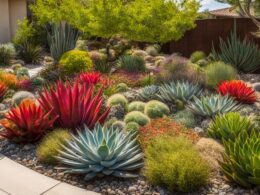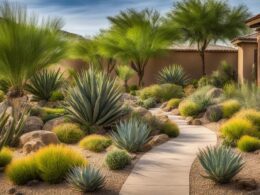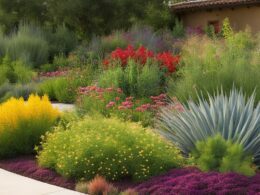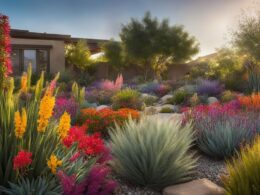Drought-tolerant landscaping with efficient irrigation is a smart and sustainable approach to creating beautiful outdoor spaces while conserving water. By utilizing water-wise practices and selecting drought-resistant plants, you can design a landscape that thrives in arid conditions and reduces water waste. In this article, we will explore the benefits of drought-tolerant landscaping and provide tips for implementing it in your own garden.
When it comes to irrigation, above ground sprinklers are not the most efficient choice. Much of the water evaporates before reaching the plants, leading to wastage. Drip irrigation is the ideal method for watering plants directly at their base, minimizing water loss and maximizing efficiency. Additionally, amending the soil before planting and incorporating drought-resistant ground cover can help improve moisture retention in the garden.
When selecting plants for a drought-tolerant landscape, focus on varieties that can withstand dry conditions. Blooming Santolina, lavender, dusty miller, and ornamental grasses are excellent choices for a water-wise garden. These plants require less water and can thrive even during periods of limited rainfall.
Drought-tolerant landscaping not only benefits the environment by conserving water but also offers advantages such as increased soil filtration capacity and reduced energy costs. By implementing these practices, you can create a resilient and visually appealing landscape that contributes to a more sustainable future.
Key Takeaways:
- Utilize drip irrigation to reduce water waste and deliver water directly to plant roots.
- Amend the soil and incorporate drought-resistant ground cover to improve moisture retention.
- Select drought-resistant plants like blooming Santolina, lavender, dusty miller, and ornamental grasses.
- Drought-tolerant landscaping offers benefits such as increased soil filtration capacity and reduced energy costs.
- Create a visually appealing and sustainable landscape by implementing water-wise practices.
Tips for Drought-Tolerant Landscaping
When it comes to creating a drought-tolerant landscape, incorporating water-saving techniques and choosing the right plants can make a significant difference. Here are some tips to help you create a beautiful and water-wise outdoor space:
- Replace part of your lawn with water-wise plantings: Lawns require a significant amount of water to stay green, so consider replacing some areas with drought-resistant plants that can thrive with less water.
- Incorporate hardscape elements: Instead of relying solely on water-needy plants, use walkways, garden art, and other hardscape features to add visual interest to your landscape without the need for excessive watering.
- Design gardens in parking strips and hell strips: These areas can be challenging to maintain and often experience soil erosion. By creating drought-tolerant gardens in these spaces, you can help conserve water and prevent soil loss.
- Consider fountains with good design: Fountains can be a beautiful addition to a drought-tolerant garden if designed to capture and recycle water. This way, you can enjoy the visual appeal of a water feature while minimizing water waste.
- Use porous materials and mulch: Opt for porous materials like gravel or permeable pavers for hardscape elements. Applying mulch around plants helps retain soil moisture, reduces evaporation, and suppresses weed growth.
- Group plants with similar water needs: By grouping plants that have similar water requirements, you can ensure more efficient watering practices and reduce water waste.
- Monitor watering practices: Keep a close eye on soil moisture levels, and adjust your watering practices based on plant needs and weather conditions. Avoid overwatering, as it can lead to root rot and other plant health issues.
- Consider alternatives to grass: Grass is one of the most water-intensive elements in a landscape. Consider removing some or all of your grass and replacing it with alternative landscaping options such as native ground cover, gravel, or low-maintenance turf alternatives.
By implementing these tips, you can create a drought-tolerant landscape that not only conserves water but also enhances the beauty and sustainability of your outdoor space.
Table:
| Plant Name | Water Requirements | Additional Benefits |
|---|---|---|
| Agave | Low | Drought-resistant, adds architectural interest |
| Lavender | Low to medium | Attracts pollinators, pleasant fragrance |
| California poppy | Low | Bright and colorful blooms, self-seeding |
| Yucca | Low to medium | Drought-resistant, adds dramatic texture |
| Ornamental grasses | Low to medium | Creates movement and texture in the landscape |
“By implementing water-saving techniques and choosing drought-resistant plants, you can create a beautiful and sustainable landscape that thrives even in dry conditions.”
Remember, drought-tolerant landscaping is not only beneficial for conserving water, but it also reduces maintenance requirements and supports the local ecosystem. Start implementing these tips today and create a landscape that is not only stunning but also environmentally friendly.
What is Drought-Tolerant Landscape Design?
Drought-tolerant landscape design is a method of creating outdoor spaces that can thrive in arid and water-scarce conditions. It focuses on practices, techniques, and plant choices that help reduce water usage while maintaining aesthetic appeal. By implementing drought-resistant and drought-tolerant plants, efficient irrigation systems, and other strategies, homeowners can create beautiful landscapes that are resilient to droughts and require minimal water.
One of the key elements of drought-tolerant landscape design is the selection of drought-resistant and drought-tolerant plants. Drought-resistant plants have natural adaptations that allow them to withstand prolonged periods of dryness, such as deep root systems or the ability to store water in their leaves. Drought-tolerant plants, on the other hand, can tolerate dry conditions but may still benefit from occasional watering. Native plants and low-maintenance varieties are often recommended for drought-tolerant landscapes, as they are well adapted to the local climate and require less water.
In addition to plant selection, efficient irrigation systems play a crucial role in drought-tolerant landscape design. Drip irrigation and micro-sprinklers are commonly used to deliver water directly to the roots of plants, minimizing water waste. The use of mulch helps retain soil moisture and suppress weed growth, while amended soil with organic matter improves water-holding capacity. Grouping plants with similar water needs allows for more efficient watering practices, ensuring that each plant receives the appropriate amount of water.
Drought-tolerant landscape design is not only beneficial for water conservation but also for creating visually appealing and sustainable outdoor spaces. By implementing these design principles and techniques, homeowners can contribute to water conservation efforts while enjoying beautiful landscapes that are resilient to drought conditions.
Benefits of Drought-Tolerant Landscape Design
- Conserves water by reducing irrigation needs
- Requires less maintenance and watering
- Creates visually appealing landscapes
- Increases biodiversity by attracting native wildlife
- Enhances property value and curb appeal
- Provides resilience to drought conditions
“Drought-tolerant landscape design is an environmentally friendly and sustainable approach to landscaping that not only conserves water but also creates beautiful outdoor spaces that can thrive in arid conditions.” – Landscape Architect
Drought-Tolerant Plant Options
| Plant Name | Sun Exposure | Water Needs |
|---|---|---|
| Lavender | Full sun | Low |
| Agave | Full sun | Low |
| Yucca | Full sun | Low |
| Ornamental Grasses | Full sun to partial shade | Low |
| Dusty Miller | Full sun to partial shade | Low |
By incorporating drought-tolerant landscape design principles and selecting suitable plants, homeowners can create beautiful and sustainable outdoor spaces that conserve water and thrive in arid conditions.
Selecting Drought-Resistant Plants
When it comes to creating a water-wise landscape, selecting drought-resistant plants is key. These plants have natural adaptations that allow them to thrive in dry conditions and require minimal watering. By choosing the right drought-resistant plants, you can create a beautiful and sustainable garden that conserves water and reduces maintenance.
One great option for drought-resistant landscaping is native plants. Native plants are well adapted to the local climate and soil conditions, making them more resilient to drought. They often have deep root systems that can access water stored in lower soil layers, allowing them to survive with minimal irrigation. Additionally, native plants provide habitat and food for local wildlife, promoting biodiversity in your garden.
Low-maintenance plants are another excellent choice for water-wise landscaping. These plants are not only drought-resistant but also require minimal care and maintenance. They are perfect for busy homeowners or those looking to reduce their water usage. Low-maintenance plants often have unique features like succulent leaves or specialized structures that help them conserve water.
Table: Examples of Drought-Resistant Plants
| Plant | Type | Water Needs |
|---|---|---|
| Agave | Succulent | Low |
| Yucca | Perennial | Low |
| Lavender | Herb | Low |
| Ornamental Grasses | Grass | Low |
| Cacti | Succulent | Very low |
By incorporating drought-resistant plants into your landscape design, you can create a beautiful and water-wise garden that thrives even in dry conditions. Remember to consider the specific needs and growing requirements of each plant when planning your garden. With careful selection and proper care, your drought-resistant plants will flourish and contribute to a sustainable and environmentally friendly landscape.
Employing Smart Gardening Practices
Implementing smart gardening practices is crucial for creating a thriving and sustainable drought-tolerant landscape. By making strategic choices and adopting efficient irrigation methods, you can conserve water and promote the health of your plants. Here are some smart gardening practices to consider:
1. Install an Efficient Irrigation System
An efficient irrigation system, such as drip irrigation or micro-sprinklers, ensures that water is delivered directly to the roots of your plants, minimizing water waste. This targeted approach also reduces the risk of evaporation and runoff, maximizing water efficiency. Consider installing a timer to automate your irrigation system and adjust watering schedules based on the specific needs of your plants and the prevailing weather conditions.
2. Apply Mulch to Retain Moisture
Applying a layer of mulch around your plants helps retain soil moisture by reducing evaporation. It also suppresses weed growth, which can compete with your plants for water. Organic mulches, such as wood chips or compost, enrich the soil as they break down, improving its water-holding capacity. Be sure to maintain a thickness of 2-4 inches and keep the mulch a few inches away from the stems of your plants to prevent rot.
3. Amend the Soil
Amending the soil with organic matter, such as compost or well-rotted manure, enhances its water-holding capacity and promotes healthy root development. Organic matter improves the soil’s structure, allowing it to retain moisture while still providing adequate drainage. Before planting, mix in compost or organic matter to a depth of 6-8 inches. This practice not only conserves water but also fosters nutrient availability and overall soil health.
By implementing these smart gardening practices, you can create a resilient and water-efficient landscape that thrives even in drought conditions. Conserving water not only benefits the environment but also reduces your water bills. Embrace these practices and watch your garden flourish with minimal water usage.
Implementing Drought-Tolerant Landscaping Across the United States
Drought-tolerant landscaping is a sustainable and water-efficient approach to outdoor design that is gaining traction across the United States. This landscaping method is particularly popular in regions with water scarcity or frequent drought conditions, such as California, Arizona, Nevada, and New Mexico. These Southwestern states have embraced water-wise landscaping to adapt to their arid and semi-arid climates. Mountainous areas and high desert regions in states like Colorado, Utah, and Idaho have also recognized the benefits of drought-tolerant landscapes in conserving water and maintaining beautiful outdoor spaces.
Even in regions with abundant rainfall, such as Florida, certain areas within the state face water scarcity, making drought-tolerant landscaping a practical choice. This approach to landscaping promotes water conservation and environmental stewardship, making it suitable for implementation in various climates throughout the country.
Drought-tolerant landscaping offers numerous advantages beyond water conservation. It reduces water bills, minimizes the carbon footprint associated with maintaining traditional landscapes, and enhances biodiversity. By choosing native plants, employing efficient irrigation systems like drip irrigation, and practicing smart gardening techniques, homeowners can create resilient and environmentally friendly outdoor spaces that thrive in the face of climate change and diminishing water resources.
Conclusion
Drought-tolerant landscaping with efficient irrigation is an excellent choice for creating sustainable and beautiful outdoor spaces. By incorporating water-saving techniques, selecting drought-resistant plants, and employing smart gardening practices, homeowners can conserve water, reduce water bills, and enhance biodiversity in their landscapes.
Drought-tolerant landscaping can be implemented across the United States, promoting water efficiency and resilience in the face of climate change and diminishing water resources. Whether you live in the arid Southwest or a region with abundant rainfall, this approach to landscaping can help you make a positive impact on the environment.
Start transforming your garden today to make it more resilient and environmentally friendly. With the right plant choices, efficient irrigation systems, and smart gardening practices, you can create an outdoor space that not only looks beautiful but also supports a healthy ecosystem. Embrace drought-tolerant landscaping and contribute to a sustainable future.
FAQ
What is drought-tolerant landscaping?
Drought-tolerant landscaping is an approach to creating outdoor spaces that thrive in arid and water-scarce conditions. It involves practices, techniques, and plant choices aimed at reducing water usage while maintaining aesthetic appeal.
Why is efficient irrigation important in drought-tolerant landscaping?
Efficient irrigation helps minimize water waste and delivers water directly to the roots of plants. This reduces water usage and ensures that plants receive the necessary moisture without excess runoff or evaporation.
What are some examples of drought-resistant plants?
Examples of drought-resistant plants include agave, yucca, lavender, cacti, ornamental grasses, and certain native wildflowers. These plants have natural adaptations that allow them to withstand prolonged periods of drought with minimal watering.
How can I incorporate water-saving techniques in my landscape?
You can reduce water usage by replacing part of your lawn with water-wise plantings, using hardscape elements like walkways and garden art, designing gardens in parking strips and hell strips, and incorporating fountains with water capture and recycling systems.
What are some smart gardening practices for drought-tolerant landscapes?
Smart gardening practices include having an efficient irrigation system, such as drip irrigation or micro-sprinklers, applying mulch to retain soil moisture, amending the soil with organic matter, grouping plants with similar water needs, and monitoring soil moisture levels.
Where can drought-tolerant landscaping be implemented in the United States?
Drought-tolerant landscaping is gaining popularity in regions with water scarcity or frequent drought conditions, such as California, Arizona, Nevada, New Mexico, Texas, and mountainous regions and high desert areas in Colorado, Utah, and Idaho. It can also be implemented in areas with abundant rainfall but face water scarcity, like certain parts of Florida.













